REL 433 - Biblical Archaeology
Course Notes
Assyria
Images in the text are linked to larger photos - click on them to see the larger pictures.
Hover the mouse over the images to see their captions and copyright credits.
The remains at the 160-acre site of Asshur include massive, second-millennium BC fortifications, ziggurats, palaces, royal tombs and residential quarters. Ancient Asshur also had at least four major temples, including a temple of the sex- and war-goddess Ishtar (third millennium BC) and a temple dedicated to the local god, the eponymous Asshur, who in the Neo-Assyrian period (early first millennium BC) became the chief Assyrian deity.
During the early second millennium, or Old Assyrian period, Asshur was an independent city-state enjoying trade relations with various Syrian, Mesopotamian and Anatolian peoples.
By the tenth century BC, Asshur had become the capital of the Neo-Assyrian Empire, which eventually controlled a vast territory from Persia to the Levant.
The Assyrian king Ashurnasirpal II (883-859 BC) relocated the capital to a site north of Asshur at Kalhu (modern Nimrud), and later Assyrian kings built capitals at Dur-Sharrukin (modern Khorsabad) and Nineveh.
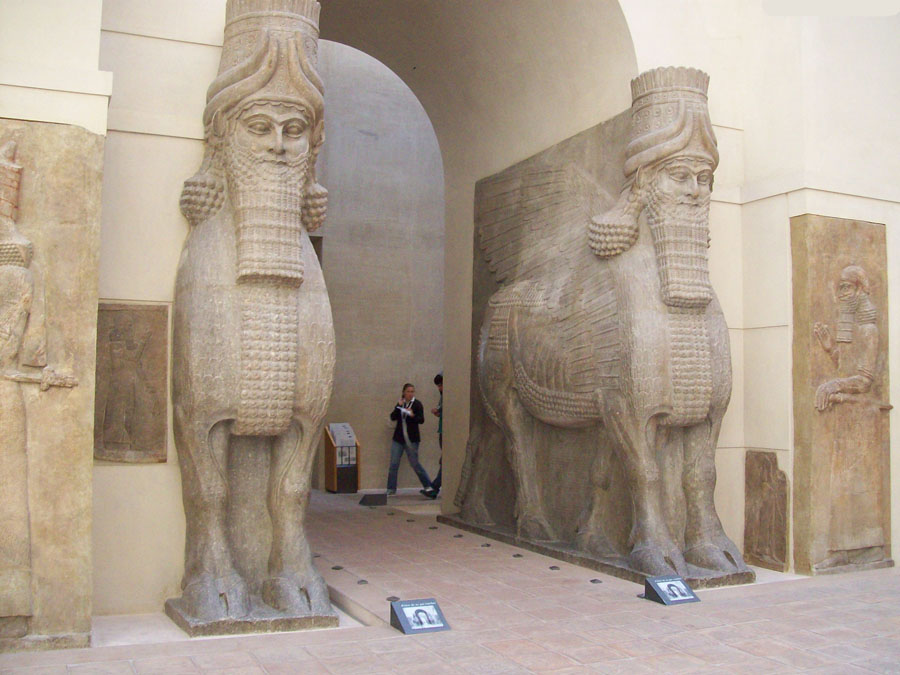
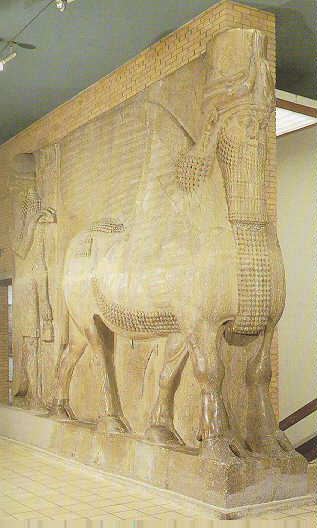
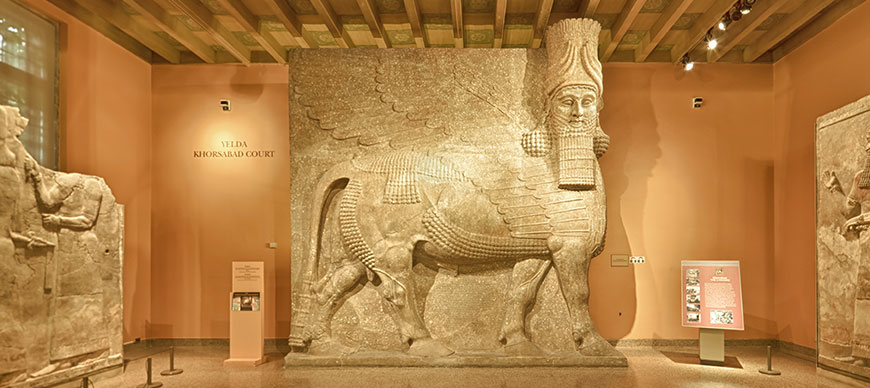
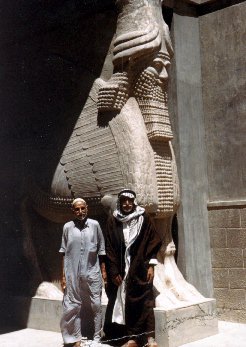 Excavation of the palace at Khorsabad yielded a number of huge statues of winged bulls. The Lamassu (winged bull) was regarded as a protective spirit.
Excavation of the palace at Khorsabad yielded a number of huge statues of winged bulls. The Lamassu (winged bull) was regarded as a protective spirit.
Asshur remained the religious center of the empire, however, until it was destroyed by an army of allied Medes and Babylonians in 614 BC.
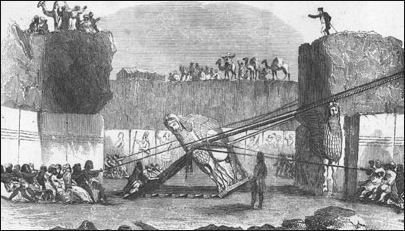 The first excavations at Asshur were conducted by the British lawyer-explorer-archaeologist Austen Henry Layard in the 1840s - though Layard put most of his efforts into digs at Kalhu and Nineveh.
The first excavations at Asshur were conducted by the British lawyer-explorer-archaeologist Austen Henry Layard in the 1840s - though Layard put most of his efforts into digs at Kalhu and Nineveh.
The site was systematically excavated in the early 20th century by Walter Andrae of the German Oriental Society, who determined the basic layout of the ancient city. Andrae's excavation reports, however, were not published until the 1960s.
In the late 1980s, two German expeditions returned to Asshur. However, the Gulf War and the ensuing embargo stopped all archaeological activity at the site.
In the late 1990s Iraqi archaeologists resumed work at Asshur, and in 2000 a German expedition headed by Peter A. Miglus of the University of Halle began excavating the site.
According to a member of the German team, Arnulf Hausleiter of Berlin's Freie Universitšt, the current excavations are especially concerned with the domestic architecture of the ancient city.
![]()
- ca.1200 BC - Shalmaneser I of Assyria
- Shalmaneser I founded the city of Nimrud and established the supremacy of Assyria
- 1146-1123 BC - Nebucahdnezzar I of Babylon
- 1116-1077 BC - Tiglath-pileser I of Assyria
- Tiglath-pileser I founded the Assyrian Empire, started to build up a military force, and conquered Babylon
- ca.1000 BC - Adadnirari II of Assyria
- Adadnirari II of Assyria attacked Babylon, took control of parts of Babylonia, and founded the Neo-Assyrian Empire in 911 BC
-
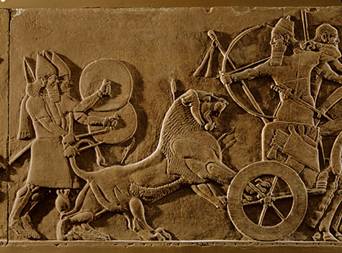 883-859 BC - Ashurnasirpal II of Assyria
883-859 BC - Ashurnasirpal II of Assyria - Ashurnasirpal II rebuilt Nimrud (Kalach) as his capital city, with a palace decorated with wall-reliefs of lion hunts (Gen.10:8-9)
- 859-824 BC - Shalmanezer III of Assyria
-
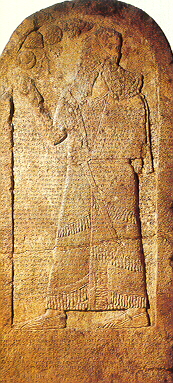
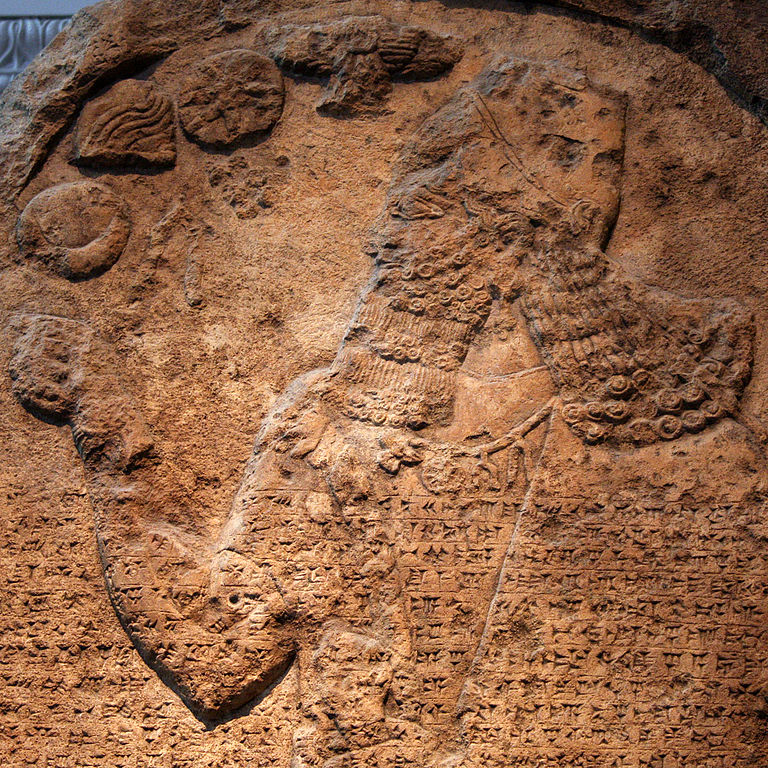
 In 853 Shalmanezer III fought the Battle of Karkar in Syria. He recorded that "10,000 foot soldiers of Ahab the Israelite" along with soldiers from 11 other kings fought against him (the Kurkh Stele)
In 853 Shalmanezer III fought the Battle of Karkar in Syria. He recorded that "10,000 foot soldiers of Ahab the Israelite" along with soldiers from 11 other kings fought against him (the Kurkh Stele)

 In 841 Shalmanezer III invaded Damascus and Israel, and exacted tribute from Jehu. The "Black Obelisk" of Shalmanezer (now in the British Museum) shows a king identified as Jehu, kneeling before Shalmanezer, and claims "the tribute of Jehu, son of Omri : I recieved from him silver, gold, a golden bowl, a golden vase with pointed bottom, golden tumblers, golden buckets, tin, a staff for a king, . . . " - Shalmanezer was either not aware of the details of Jehu's accession, or was using the term "son of Omri" to mean that Jehu was ruling the region that Omri used to dominate
In 841 Shalmanezer III invaded Damascus and Israel, and exacted tribute from Jehu. The "Black Obelisk" of Shalmanezer (now in the British Museum) shows a king identified as Jehu, kneeling before Shalmanezer, and claims "the tribute of Jehu, son of Omri : I recieved from him silver, gold, a golden bowl, a golden vase with pointed bottom, golden tumblers, golden buckets, tin, a staff for a king, . . . " - Shalmanezer was either not aware of the details of Jehu's accession, or was using the term "son of Omri" to mean that Jehu was ruling the region that Omri used to dominate
Shalmanezer III also attacked Babylon, sacked the city and killed its king; then he installed vassal kings to rule and pay tribute to him. - 823-811 BC - Shamshi-Adad V of Assyria
-
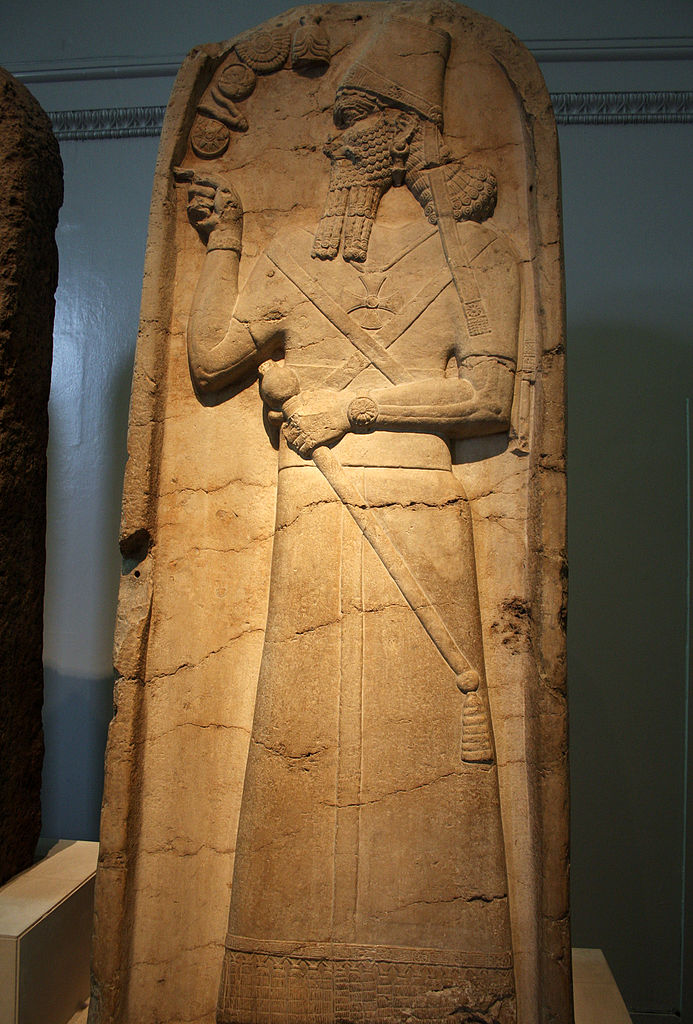
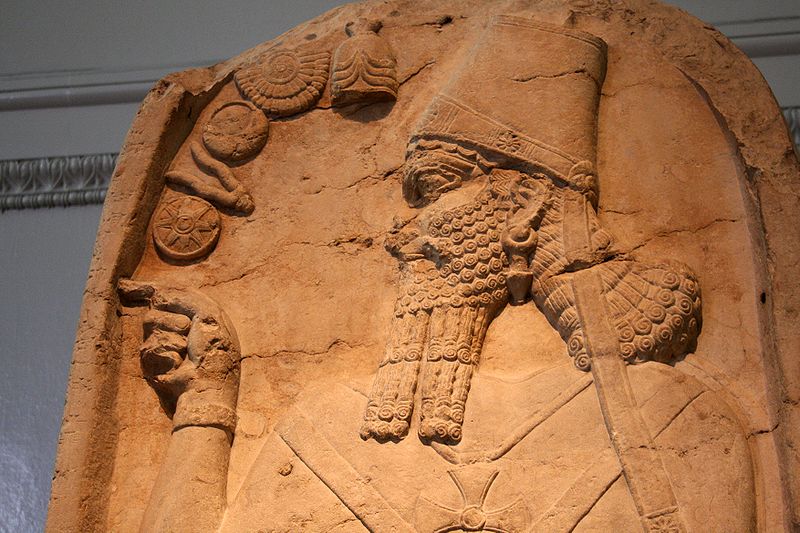
-
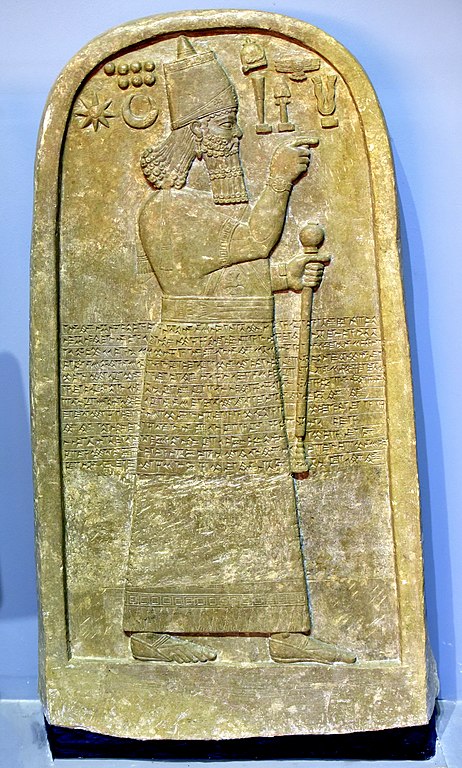 811-783 BC - Adad-nirari III of Assyria
811-783 BC - Adad-nirari III of Assyria - In 803 Adad-nirari III invaded Syria, and in 796 he besieged Damascus. The Assyrians began to adopt Aramaic as their language. Adad-nirari erected a stele to himself, in which he mentioned "Jehoash the Samarian" (Jehoash is mentioned briefly in II Kings 13:10-13
- Shalmaneser IV
- 745-727 BC - Tiglath-pileser III ("Pul") of Assyria
-
 Tiglath-pileser III invaded the Northern Kingdom of Israel and exacted a heavy tribute from King Menahem. Then, in the succeeding reign of Pekah, Tiglath-pileser invaded again and captured Hazor and much of the Galilee. (II Kings 15:19-20, 29)
Tiglath-pileser III invaded the Northern Kingdom of Israel and exacted a heavy tribute from King Menahem. Then, in the succeeding reign of Pekah, Tiglath-pileser invaded again and captured Hazor and much of the Galilee. (II Kings 15:19-20, 29) - 727-722 BC - Shalmanezer V of Assyria
- Shalmanezer V invaded the Northern Kingdom of Israel, and in 722 Samaria fell to Shalmaneser V and/or Sargon II, and the Northern Kingdom of Israel came to an end. The Israelite people were taken into captivity in Assyria, and became "the Ten Lost Tribes of Israel".
Various conquered peoples were moved into the area by the Assyrians. They became the "Samaritans" II Kings 17:3-6, 23-24
Shalmaneser V had declared himself to be king of Babylon also, but he died in 727 during the Siege of Samaria, and Babylon tried to break free of Assyrian domination. Eventually Sargon II of Assyria took control and became king of Babylon as well as Assyria. -
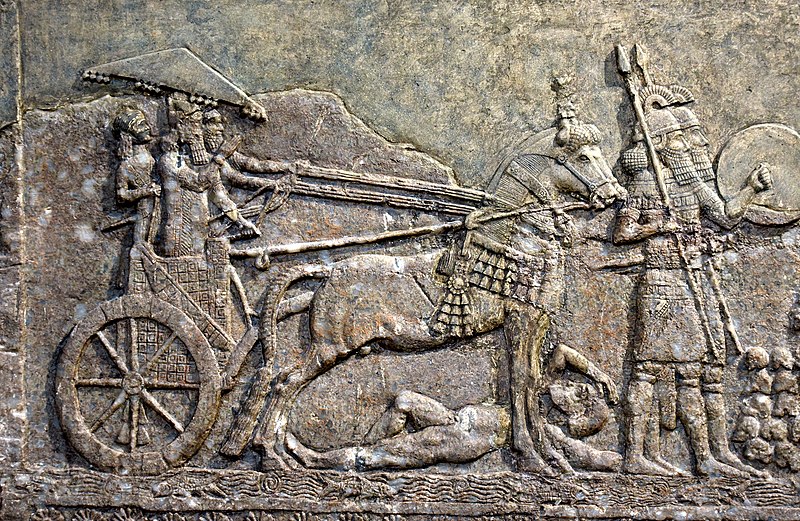
 722-705 BC - Sargon II of Assyria
722-705 BC - Sargon II of Assyria - Sargon II conquered the Hittites, the Chaldeans, and Samaria, and regained contorl of Babylon in 710 BC.
- 721-710 BC - Merodach-baladan king of Babylonia
- Merodach-baladan managed to separate his kingdom from the Assyrian empire temporarily
- 710 BC
- Sargon II of Assyria regained control of Babylon. Merodach-baladan fled to Elam until 701 BC when he claimed Babylon again
- 705-681 BC - Sennacherib of Assyria
-
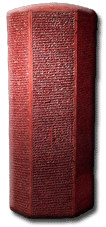
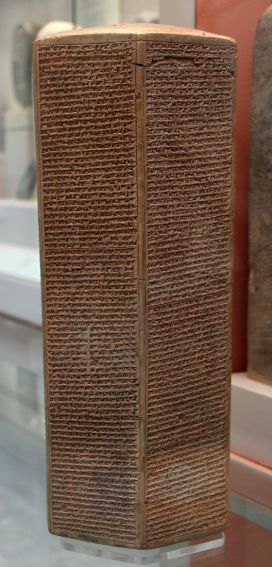 In 701 Sennacherib invaded Judah and laid siege to Jerusalem - though he did not manage to capture it. Sennacherib's accounts of the campaign are given on the "Sennacherib Prism" (now in the Oriental Institute, University of Chicago) and the "Taylor Prism" (now in the British Museum) and in several other inscriptions.
In 701 Sennacherib invaded Judah and laid siege to Jerusalem - though he did not manage to capture it. Sennacherib's accounts of the campaign are given on the "Sennacherib Prism" (now in the Oriental Institute, University of Chicago) and the "Taylor Prism" (now in the British Museum) and in several other inscriptions.
In 1851 Henry Rawlinson published the translation of the text. (compare the Biblical account, II Kings 18:13-19:36)"As for Hezekiah the Judahite who had not submitted to my yoke, I surrounded 46 of his strong walled towns, and innumerable small places around them, and conquered them by means of earth ramps and siege engines, attack by infantrymen, mining, breaching, and scaling. 200,150 people of all ranks, men and women, horses, mules, donkeys, camels, cattle and sheep without number I brought out and counted as spoil. He himself I shut up in Jerusalem, his royal city, like a bird in a cage. . . . Now the fear of my lordly splendour overwhelmed that Hezekiah. The warriors and select troops he had brought in to strengthen his royal city, Jerusalem, did not fight. He had brought after me to Nineveh, my royal city, 30 talents of gold, 800 talents of silver, best antimony, great blocks of red stone, ivory-decorated beds, ivory-decorated chairs, elephant hide, tusks, ebony, box-wood, valuable treasures of every sort, and his daughters, women of his palace, men and women singers. He sent his messenger to pay tribute and do obeisance."
In 700 Sennacherib ousted Merodach-baladan, who fled to Elam once more, and died ca.694 BC
The Assyrians destroyed Babylon and diverted the River Euphrates to cover the remains of the city. The Assyrians were thorough when they set out to destroy something.
Sennacherib went on to attack Egypt, capture some of the leading cities, and defeat Pharaoh Tirhakah (the "Black Pharaoh") at Eltekeh. Sennacherib was murdered by two of his own sons in the temple at Nineveh in 681 BC, and was succeeded by his son Esarhaddon - 700-675 BC - Achaemenes of Persia
- Achaemenes was the founder of the Achaemenid dynasty. The Persians held the hilly country to the east of Babylon. They were rich, but not yet one of the leading powers
- 690-664 BC - Pharaoh Tirhakah of Egypt
- Pharaoh Tirhakah of Egypt's 25th (Ethiopian) dynasty was defeated at Eltekeh by Sennacherib)
- 681-669 BC - Esarhaddon of Assyria
-
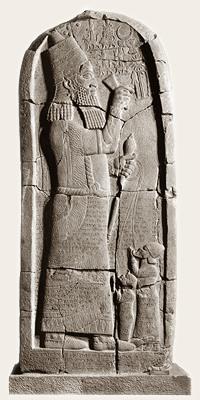 Esarhaddon was the son of Sennacherib (II Kings 18:37, Isaiah 37:38). He rebuilt Babylon because he thought that the god Marduk of Babylon was angry with him.
Esarhaddon was the son of Sennacherib (II Kings 18:37, Isaiah 37:38). He rebuilt Babylon because he thought that the god Marduk of Babylon was angry with him.
One of his memorials is a stele which shows him with two captive kings - their lips have been pierced by hooks, to which leashes are attached. Esarhaddon holds them like dogs on a leash.
At the end of his life, Esarhaddon made his eldest son Shamash-shum-ukin king of Babylon, and gave his youngest son Ashurbanipal the senior position of king of Assyria. After some years of subjugation, Shamash-shum-ukin led a rebellion against his brother. Ashurbanipal quashed the revolt with brutal force, Babylon was sacked, and Shamash-shum-ukin died. - 675-640 BC - Teispes (Chishpish) of Persia
- Teispes (Chishpish) was the son of Achaemenes I of the Achaemenid dynasty of Persia
- ca.670-650 BC - Phraortes (Kashtariti ?) the Mede
- Phraortes united the Medes against the Assyrians and fought Teispes of Persia
-
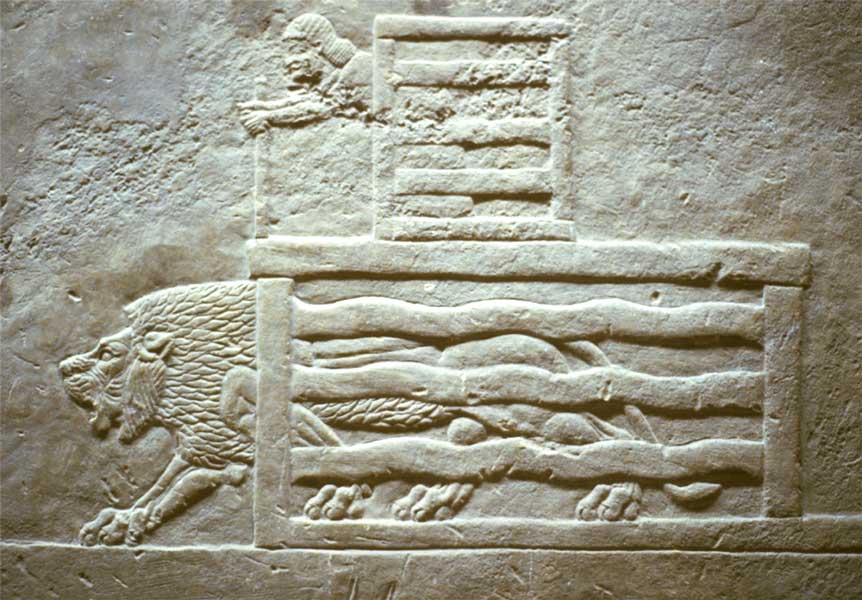
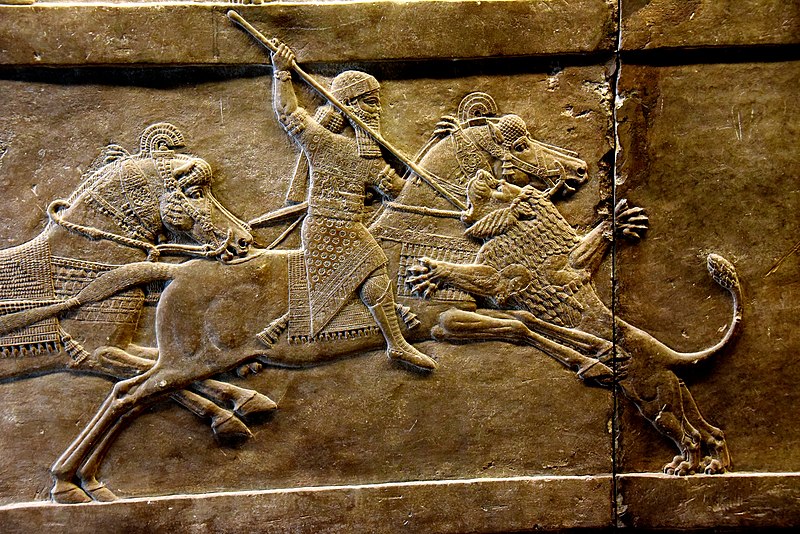
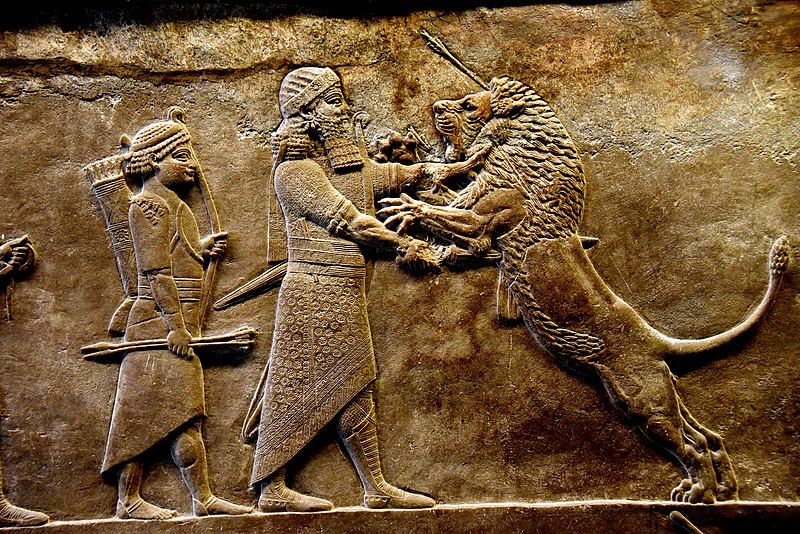 669-633 BC - Ashurbanipal of Assyria
669-633 BC - Ashurbanipal of Assyria -
 Ashurbanipal was the son of Esarhaddon.
Ashurbanipal was the son of Esarhaddon.
After killing his older brother, who had been made king of Babylon by his father Esarhaddon, Ashurbanipal took control of Babylon and appointed a governor to rule for him. He began to assemble a library in Nineveh of all the literature of Mesopotamia (30,000 tablets from this library have been uncovered). One of his favorite sports seems to have been killing captive lions - he decorated his palace at Nineveh with wall reliefs showing his prowess.
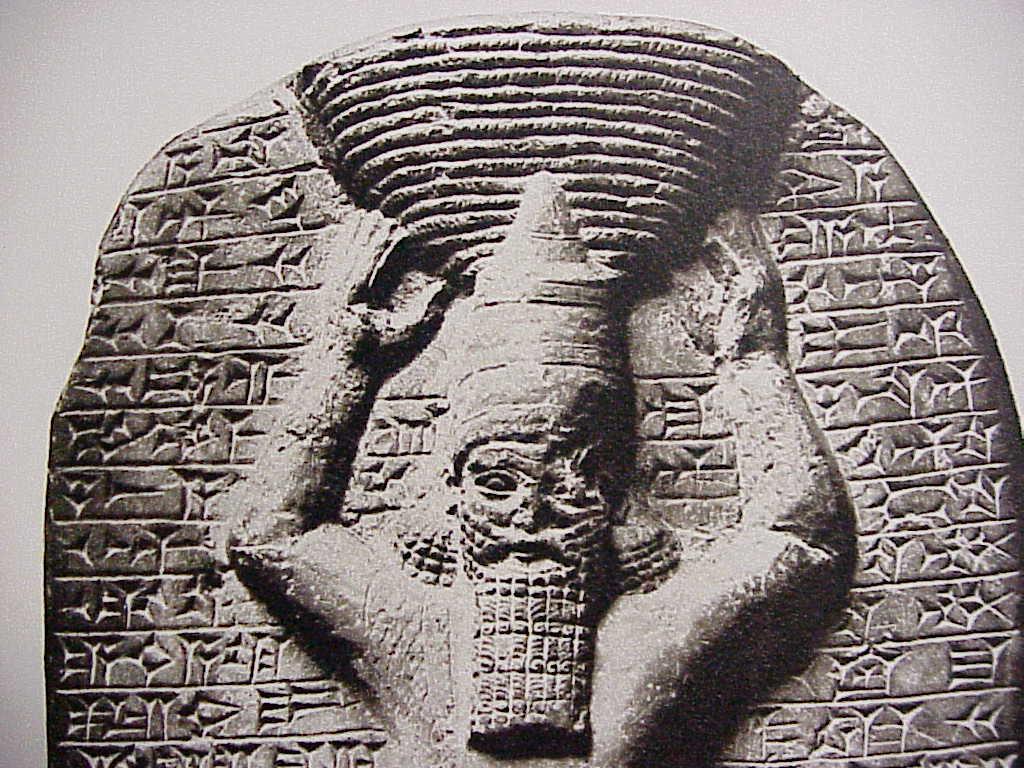
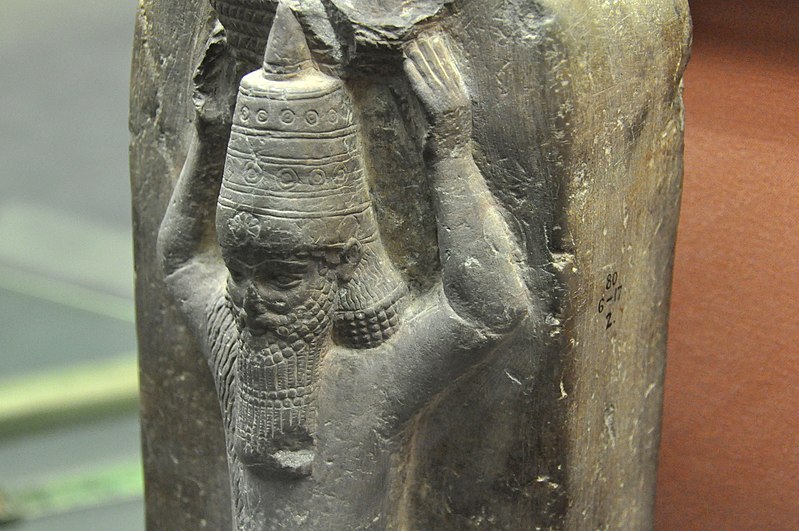
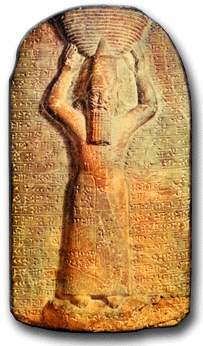 He erected stelae to remind the gods of Babylon that he had helped in the rebuilding of the Temple of Esagila at Babylon.
He erected stelae to remind the gods of Babylon that he had helped in the rebuilding of the Temple of Esagila at Babylon.
In 652 Ashurbanipal took Manasseh, king of Judah, as a prisoner to Assyria
After the death of Ashurbanipal the Empire disintegrated into civil war; client kingdoms broke free, and the way was open for Babylon to seize control of Mesopotamia. - ca.650 BC - Zarathustra (Zoroaster) founded Zoroastrianism
- Zoroastrianism is a dualistic religion which inspired the Persians to a program of conquest. The Persians were an Indo-European people living to the north of the Persian Gulf, away from the main areas of political unrest and war. Within 100 years of Zoroaster's teaching, the Persians, under Cyrus, founded a great empire and set about trying to conquer the whole world for Zoroastrianism
- 640-600 BC - Cyrus I of Persia
- Cyrus I was the son of Teispes, of the Achaemenid dynasty of Persia
- 626-605 BC - Nabopolassar of Babylon - Power passes from Assyria to Babylon
- Nabopolassar was a Chaldean general who seized control of the region that had been Babylon, and declared his independence from Assyria.
In 612 Nabopolassar conquered Nineveh and the Assyrian Empire. Nineveh was burnt to the ground.
The Assyrian army fought on for about another 2 years, then was defeated at Haran.
Cyaxares, king of the Medes, and Nabopolassar of Babylon formed an alliance. The crown prince Nebuchadnezzar of Babylon married a Median princess and built the hanging gardens of Babylon for her
Copyright © 1999 Shirley J. Rollinson, all Rights Reserved